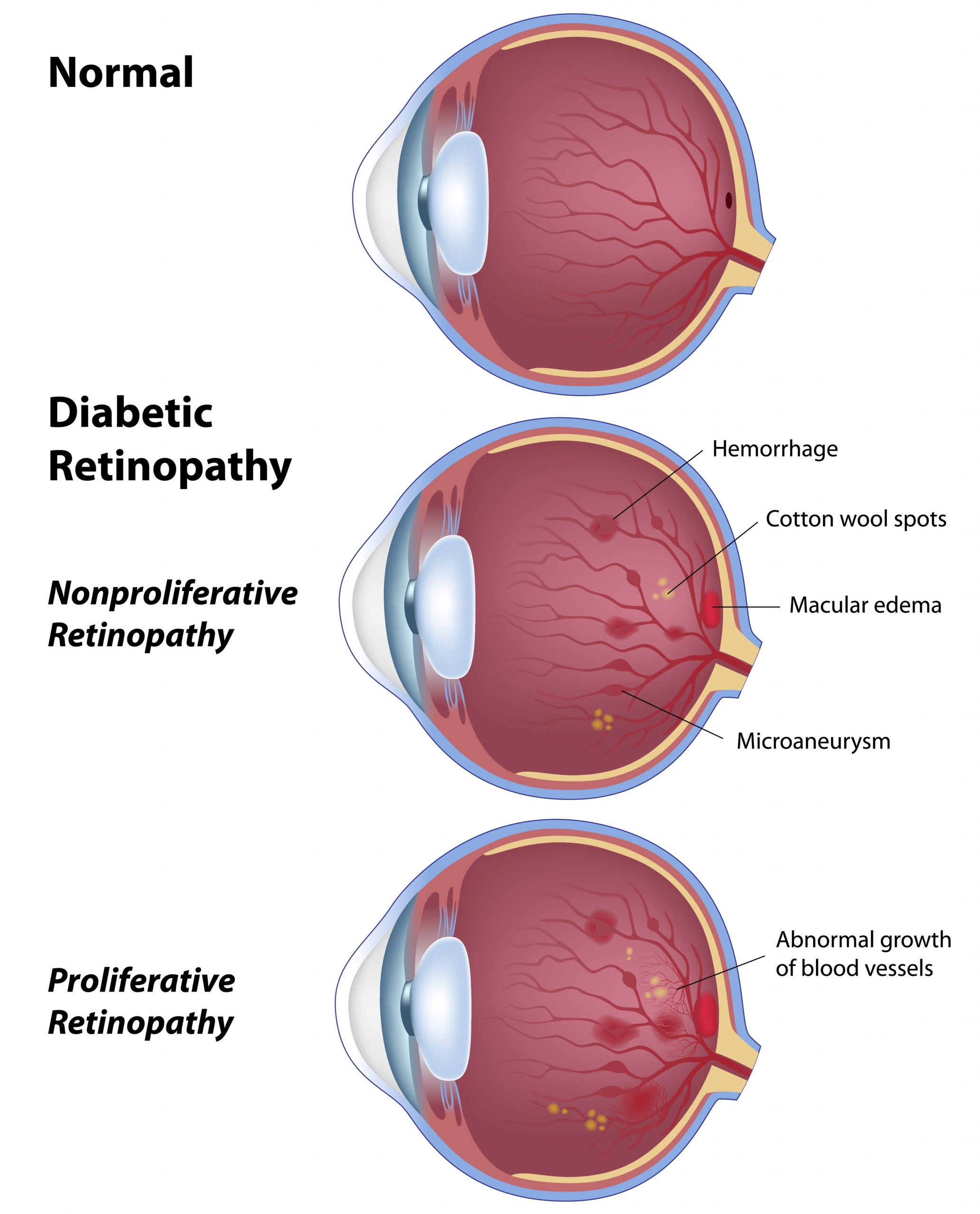Diabetes may cause several diseases of the eye:
Diabetic retinopathy: the capillaries of the retina are damaged, and allow fluid to escape, which may affect vision (diabetic macular œdema). Abnormal new blood vessels may also develop (proliferative retinopathy). In the absence of quick treatment, they may lead to blindness.
Cataract: clouding of the lens of the eye, leading to reduced eyesight, is much more common in diabetes, and appears much earlier in life than it does in healthy individuals.
Glaucoma: this lesion of the optic nerve tends to appear earlier in diabetics.
Anterior ischemic optic neuropathy (AION): a sudden interruption in the flow of blood to the optic nerve, causing major vision impairment (similar to an optic nerve attack).
Keratopathy: chronic lesions of the cornea, causing irritation, redness, dry eye, tearing, and sometimes vision impairment.
Paralysis of the ocular muscles: interruption of the flow of blood to the nerves which control the movement of both eyes, resulting in seeing double.
Retinal vascular occlusion: sudden obstruction of the arteries or veins of the retina, sometimes leading to significant vision impairment.
Regular monitoring is necessary, because most of the eye disorders diabetes causes do not show any symptoms until they have reached an advanced stage.
Most of the major visual impairments caused by diabetes can be avoided by following certain recommendations:
– Keep blood sugar levels as close to normal as possible: A level of about 6% considerably reduces the risk of developing eye complications.
- Keep blood pressure levels close to normal with diet, exercise, and medication.
- Keep cholesterol levels low with diet, exercise, and medication.
- Don’t smoke: tobacco constricts vessels that are already weakened.
- Have your ophthalmologist perform a dilated-eye exam regularly: early diagnosis and appropriate treatment make it possible to avoid serious visual impairment, in most cases.
Treatment
Proliferative diabetic retinopathy is treated with panretinal photocoagulation (PRP) using a laser. This is an outpatient procedure performed under local anaesthesia (eye drops). In most cases, several sessions are necessary. However, the procedure does cauterize new blood vessels in most patients, and considerably reduces the risk of blindness.
Today, œdematous maculopathy is treated with intravitreal “anti-VEGF” injections in the vast majority of cases. Lucentis ® (ranibizumab) and Eylea ® (aflibercept) are the most commonly used drugs. The injection is an outpatient procedure. After eye drops are applied to numb the eye, it takes only a matter of seconds. Several injections are required to treat diabetic macular œdema over a period lasting several years.
Intravitreal injection of corticosteroids is indicated for certain patients. Corticosteroid therapy is effective for four to six months, on the average, making it possible to reduce the number of injections.
Laser photocoagulation was long the only treatment available for patients with diabetic macular œdema. It may still be indicated today, in certain cases.
OPHTHALMOLOGY CENTER
Ophthalmological consultation and treatment center located next to Place de Paris, in Luxembourg.
Dr Christian Eulufi
Dr Tom Pavant
Dr Carla Schmartz
Dr Philippine Delvaulx
Dr Mihaela Dilion
USEFUL INFORMATION
34, avenue de la Liberté
L-1930 Luxembourg
Opening time
Monday, Tuesday, Thursday and Friday: 8 a.m. to 12 p.m. and 1:30 p.m. to 5 p.m.
Wednesday: 8 a.m. to 12 p.m.
MAKE AN APPOINTMENT
By phone at +352 28 86 72
Monday to Friday 8 a.m. to 12 p.m. and 1:30 p.m. to 3 p.m., except Wednesday afternoon
By email by writing to [email protected]
Comprehensive care for the patient


